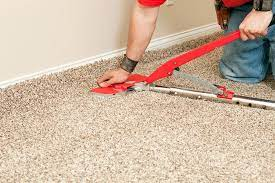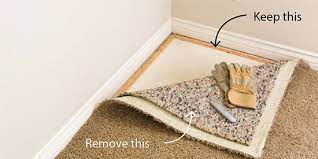The intricacies of carpet installation often extend beyond the simple selection and purchase of a preferred material. The process is nuanced, governed by several factors that determine its duration and efficacy. This article will delve into the depths of these considerations, shining a light on elements such as preparation steps, choice of materials, professional hiring decisions, actual installation procedures, post-installation care guidelines and troubleshooting tips. It will also explore the maintenance practices that influence the lifespan of your carpet. By understanding this comprehensive procedure, one can effectively plan for carpet installation within their spaces.
This exploration targets those driven by a subconscious desire for mastery – individuals who seek not just to understand but to excel in their undertakings. To these ends it adopts an academic style of writing which remains objective and impersonal while still captivating interest with engaging content. Enjoy this journey through the world of carpets; from pre-purchase decision making all through to ensuring longevity in use after successful installation.
Preparation Steps
Before the installation of carpet can commence, several crucial preparation steps must be undertaken, a process that can add substantial time to the overall project duration. The timeframe for installing carpet is not merely down to the physical act of laying it; it also includes the time taken in handling these preparatory actions. Firstly, an assessment and measurement of the room or rooms where the carpet will be laid is required. This initial phase ensures that enough material is purchased and also determines any obstacles that might slow down installation. The surface onto which the carpet will be installed must then be thoroughly cleaned and dried to establish an optimal foundation for installation.
The second stage involves acquiring all necessary materials and tools needed for efficient carpeting process. It’s important to note that cutting corners at this stage could result in longer carpet installation time due to issues arising during fitting. For instance, having insufficient underlay or using inappropriate adhesives may necessitate corrections midway through installing, slowing down what could have been a quick carpeting process.
Lastly, removing furniture from rooms where carpet will be installed significantly speeds up the sell my house fast Fort Worth process as well; thus reducing downtime caused by moving items around during work hours. Once all these prerequisites are met, consideration should then turn towards choosing suitable material for your space. A well-prepared area paves way for smooth sailing when deciding on whether plush pile or Berber weave would best complement your interior décor style in terms of both aesthetics and functionality.
Choosing the Right Material
Selecting the appropriate material is a pivotal step in the carpet laying process, as it significantly influences the duration and complexity of the installation. The type of carpet selected can either streamline or impede the speed of carpet installation. For instance, some materials are easier to cut and fit around corners than others. Thus, understanding the properties of different materials can provide quick carpet installation tips.
The following table provides an overview of four common types of carpets, their descriptions, and how they may impact your carpet installation timeline.
| Carpet Type | Description | Impact on Installation Time |
|---|---|---|
| Wool | Natural fiber that offers durability, luxury feel, and high cost. | Requires professional expertise due to its delicate nature – potentially leading to longer install times. |
| Nylon | Synthetic fiber known for its resilience and stain resistance. | Easy to install due to its flexibility – offering fast carpeting solutions. |
| Polyester | Affordable synthetic option with vibrant color clarity. | Less resilient than nylon but relatively easy to lay – contributing towards faster installs. |
| Olefin | Budget-friendly synthetic fiber suitable for low-traffic areas. | Light and easy to work with – providing another avenue for a fast carpet installation. |
Understanding these differences aids in making sell my house fast Texas informed decisions about what kind of material best suits one’s needs while still adhering to desired timelines for completion. It is worth noting that regardless of material chosen, proper preparation is crucial in ensuring an efficient process.
While choosing the right material can expedite the process considerably, there are other factors also critical in achieving an efficient project execution which shouldn’t be overlooked. One such factor being whether or not one should engage professional help during this process – a topic warranting thoughtful consideration which will be explored next.
Hiring a Professional

Weighing the benefits and drawbacks of hiring a professional for carpet installation is a crucial aspect that can significantly impact both the project timeline and quality of workmanship. When contemplating how long does it take to install carpet, hiring a professional could potentially expedite the process. Professionals come equipped with extensive experience and tools necessary to tackle any obstacles that may arise during installation. Additionally, they possess knowledge on additional keywords for carpet installation such as ‘seaming’, ‘padding’, and ‘tackless strips’, which are integral elements of the fitting process.
The consideration of whether to hire a professional extends beyond just time efficiency. Quality is another essential factor in this equation. Carpet installation involves precise measurements, cutting, seaming, stretching, and securing – tasks that demand specific skills acquired through training and practice. In contrast to DIY projects where errors might occur due to lack of expertise or inappropriate tools leading to unsatisfactory results or prolonged timelines, professionals ensure accuracy in execution thus promising superior finish within the estimated timeframe.
While there’s an undeniable upfront investment involved in hiring a professional for carpet installation, considering not only the potential time saved but also the assurance of a well-executed job makes this option worth considering. As we transition into understanding more about what’s involved in carpet installations themselves – from choosing your material all the way through its implementation – keep these considerations around professionals’ roles at top-of-mind since their input can significantly shape your overall experience with installing carpets.
Installation Process

Understanding the intricacies of the carpet installation process is pivotal to appreciate its complexity and the skills required for flawless execution. The journey begins with an initial assessment, where measurements are taken and appropriate materials are chosen. This phase is critical as it determines how much carpeting will be needed, which directly influences cost and timeline. Ensuring precision at this stage can expedite a quick house sale, as potential buyers often look for homes that do not require additional work or renovations.
The actual installation then commences with old carpet removal if necessary, followed by floor preparation which may involve minor repairs to create a smooth surface for the new carpet. Subsequently, a layer of padding is installed to provide cushioning before rolling out and securing the new carpet in place. Trimming off excess material and fastening edges securely completes this step of the process. A detailed understanding of these stages can contribute significantly towards a fast home selling experience; well-laid carpets can enhance property value thus facilitating speedy property sales.
Following successful installation, inspection becomes crucial to ensure all aspects have been accurately executed and there are no visible defects or imperfections that might affect its durability or aesthetic appeal. Moreover, professional installers usually offer advice on how best to maintain your new carpet – invaluable information that should not be underestimated when aiming for rapid house transactions since well-maintained carpets signify meticulous homeownership. Maintaining this level of attention post-installation will undoubtedly serve as an advantageous element in future discussions about property condition or value considerations during negotiations.
Post-Installation Care

Ensuring the longevity and appearance of newly installed carpets depends greatly on regular and appropriate post-installation care. The related keywords for how long does it take to install carpet play a vital role in understanding the importance of this stage. While the actual installation process may be quick, neglecting proper maintenance can lead to early wear and tear, diminishing both the aesthetic appeal and functional value of the carpet. In swift home sale processes or speedy real estate transactions, potential buyers often scrutinize these details as they reflect overall property upkeep.
Post-installation care involves several critical actions:
- Regular vacuuming: This helps remove dirt particles that can degrade carpet fibers over time.
- Immediate stain treatment: Spills should be addressed promptly to prevent permanent stains.
- Professional cleaning: Engaging professionals for periodic deep cleaning maintains carpet freshness and prolongs lifespan.
In any quick property sale, well-maintained carpets could potentially enhance property value by contributing positively to its overall appeal. Therefore, incorporating regular post-installation care into one’s routine is not just about maintaining appearances; it serves as an investment towards preserving or improving property value in anticipation of future transactions.
Without detracting from the importance of initial installation timescales, it becomes clear that effective post-installation care is pivotal in ensuring a longer-lasting and more presentable carpet. This process goes beyond mere maintenance; it incorporates elements that are crucial to enhancing aesthetic appeal while also serving as a potential factor in expediting future real estate transactions. As we transition into discussing troubleshooting tips, remember that identifying common problems early on forms part of comprehensive post-installation care regimen.
Troubleshooting Tips
Navigating the challenges that may arise post-carpet installation can be simplified with a few key troubleshooting tips. For instance, one common issue is carpet buckling or wrinkling which can occur due to poor installation, incorrect padding size or environmental factors such as high humidity. This not only compromises the aesthetic appeal of the carpet but it could also act as a deterrent for efficient home selling. To rectify this, it is advisable to engage professional services for re-stretching or replacing the affected sections.
In relation to additional keywords for selling houses fast, addressing persistent odors is paramount. Carpets can often trap and hold unpleasant smells from pets, smoke or cooking which could potentially affect your ability to sell a house quickly. Regular deep cleaning using suitable carpet cleaning solutions can help mitigate these odors. However, if the odor persists after several attempts at cleaning, replacement of the carpet might be necessary.
Understanding and promptly addressing these common issues not only ensures longevity of your investment but also contributes significantly towards fast home closing deals by enhancing interior aesthetics and eliminating potential deal breakers for prospective buyers. As we transition into discussing maintenance and lifespan considerations of carpets, it’s important to remember that proactive care begins from day one post-installation and extends throughout its lifetime in order to maximize its value.
Maintenance and Lifespan
Having navigated through the terrain of potential troubleshooting issues in carpet installation, it is crucial to delve into an equally significant aspect – the maintenance and lifespan of carpets. This area offers a broader perspective on what can be expected after successfully installing your carpet and how best to sustain its quality over time.
- Regular Cleaning: A fundamental step towards extending the life of a carpet lies in consistent cleaning routines. This includes vacuuming at least once a week, more often if the area experiences high traffic or pets are present. Deep cleaning should also be scheduled annually with a professional service.
- Stain Prevention: Immediately attending to spills or stains extends not only the aesthetic appeal but also the longevity of carpets. Using commercial stain removers is recommended for stubborn stains; however, natural alternatives such as white vinegar diluted with warm water can also be effective.
- Carpet Padding: In order to ensure maximum comfort and durability, it is advisable to install good quality padding beneath your carpet. It not only provides additional cushioning but also helps reduce wear and tear by absorbing impact.
- Professional Installation: Lastly, having carpets installed by professionals ensures proper fitting and reduces chances of errors that could lead to premature wear or damage.
Understanding these maintenance practices underlines their utility in prolonging a carpet’s lifespan beyond mere aesthetics; they serve as essential guidelines for preserving its structural integrity over time as well. Notably absent from this discussion thus far has been an explicit mention of said timeframe – how long, exactly, does one expect a properly maintained carpet to last?
While it depends significantly on factors like usage intensity and initial quality, most residential carpets tend to have an average lifespan ranging from 5-15 years with appropriate care. Henceforth, remember that successful installation marks just the beginning of your journey with your new carpet – ongoing maintenance efforts are pivotal in ensuring you enjoy its warmth and beauty for years ahead without undue complications or premature replacement costs becoming burdensome.
Frequently Asked Questions
What are the cost implications of carpet installation?
Carpet installation costs vary significantly based on factors such as carpet type, room size, and labor fees. Installation may range from $2 to $8 per square foot, with average total costs between $500 and $2000.
Can carpet installation affect the value of my home?
Indeed, carpet installation can influence a home’s value. Quality carpets, professionally installed, enhance aesthetic appeal and comfort, potentially increasing property value. However, individual preferences and market trends impact the extent of this effect.
Is it possible to install carpet over existing floor types like tile or wood?
Yes, it is feasible to install carpet over existing floor types such as tile or wood. However, the process necessitates careful preparation and may present challenges depending on the condition of the underlying flooring.
Are there any health or allergy considerations when installing a new carpet?
Yes, new carpet installation may incite allergic reactions or respiratory issues due to volatile organic compounds (VOCs) emitted. Therefore, selecting low-VOC carpets and ensuring proper ventilation during installation is crucial for health safety.
How does climate or weather condition affect the installation and durability of carpets?
Climate and weather conditions significantly influence the installation and longevity of carpets. High humidity can slow down adhesive drying times, potentially damaging the carpet, while extreme temperatures can cause shrinkage or expansion.
Other Articles You Might Enjoy
How Long Does It Take To Receive Inheritance From A Trust

